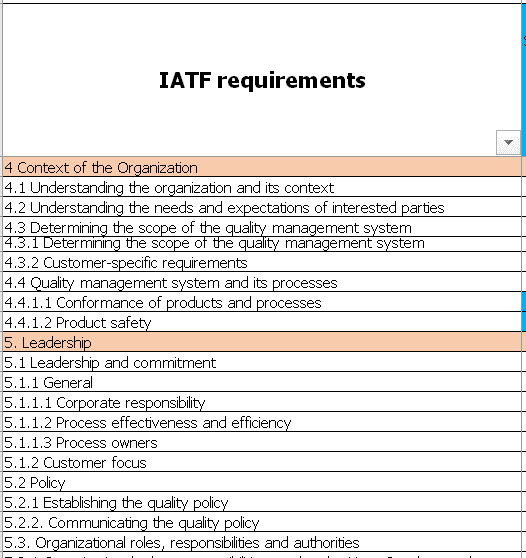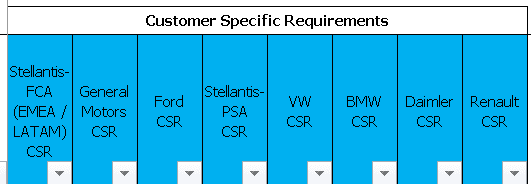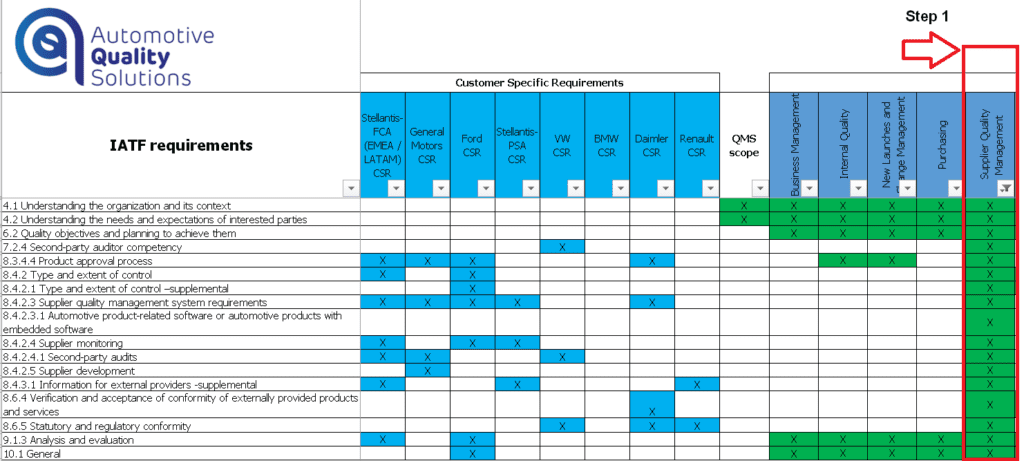IATF 4.3.2 Customer Specific Requirements do not only apply to the quality department. In fact, they relate to the vast majority of the company’s business processes.
One of the proposals for their identification and management is applying of a requirements matrix.
IATF standard assumptions
According to IATF requirements, the production plant should periodically assess Customer Specific Requirements (CSR). In practice, the first assessment is carried out in preparation for IATF certification. The next ones, on the other hand, can be carried out while updating customer-specific requirements from particular OEM’s. The way to be kept informed about updates is described in a separate article.
Some organizations have appropriate central departments that analyze the CSR of individual clients (OEM’s). Why is it so important? Because it happens that at the central level there are deviations from CSR applying. For example, they can relate to the use of an organization’s forms in place of the customer during sub-suppliers (Tier 2) assessment.
IATF 4.3.2 Customer Specific Requirements – how to fulfill?
One of the proposals for the implementation of the above requirement is the use of a matrix that will contain a list of IATF, CSR requirements and business processes used by production plant.

Fig. 1. Matrix showing the relationship between IATF, CSR requirements and business processes.
The entire structure of the document should be very clear. First, we list all IATF requirements.

Fig. 2. The column with the IATF requirements listed.
Then we identify the requirements for which customer CSR’s exist. In the presented document these are: Stellantis-FCA (EMEA / LALTAM), GM, Ford, Stellantis-PSA, VW, BMW, Mercedes and Renault.

Fig. 3. Customer Specific Requirements
The QMS scope is in the next column. The document itself should contain, among others. scope of the quality management system and documented processes with inputs and outputs connections. Most often, processes are represented by the use of a turtle diagram. The QMS scope itself should also contain a document (e.g. the matrix described in the article) indicating the location of specific customer requirements.
On the right side of the matrix, there are the most common business processes that are implemented in the production of components for the automotive industry. These include: Business Management, External Quality, New Launches and Change Management, Purchasing (most often carried out by other locations – Remote Location), Supplier Quality Management, Logistic, Production, Process Quality, Maintenance, HR, Continuous Improvement (optional), QMS Management, EHS, Finance and IT Department.

Fig. 4. List of the most commonly used business processes in the plant.
IATF 4.3.2 Customer Specific Requirements – how to use the matrix?

Fig. 5. Presentation of the first step on the example of the “Supplier Quality Management” process
In the next section, we filter Customer Specific Requirements that interest us (set the filter to “X”). As can be seen from the Supplier Quality Management example, there are seven Stellantis-FCA customer specific requirements for this process that must be analyzed and implemented.

Fig. 6. Presentation of the second step on the example of the “Supplier Quality Management” process and Stellantis-FCA CSR.
For this reason, the requirements matrix is most often used by process owners to identify what specific requirements apply to their area and whether they are fully implemented.
Another group that should use the requirements matrix are internal auditors who carry out system audits. One of the things that are done for this activity is the verification of the client’s CSR, which is carried out in the audited process.
You can download an automatic, editable Excel form for free on the Free Quality Tools
Document name: Requirements matrix as an implementation of IATF 4.3.2 Specific Customer Requirements – Excel form


